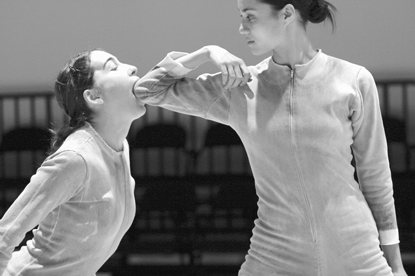Elegant, eloquent, and riveting “Mamootot” from Batsheva Dance
By GUS SOLOMONS JR.
Batsheva Dance Company, Israel’s premier modern troupe, brought a challenging work, made in 2003 by its artistic director and chief choreographer Ohad Naharin, to this season’s Next Wave Festival at BAM.
Eschewing a theater setting, “Mamootot” (mah-MOO-tote) was staged in the James and Martha Duffy Performance Space in the Mark Morris Dance Center across from the opera house November 15 through 27. The audience sat in two rows of folding chairs that lined the four walls of the wide, white, rectangular room, except for the entrance doors on opposite sides. Lighting, designed by Avi Yona Bueno-Bambi, consisted of bright overhead illumination; it remained unchanged throughout the hour-long piece.
In the performance on November 23, female dancer Noa Zouk unceremoniously enters the space and in silence dances a stretchy, sinewy solo of deep knees bends in distorted stances, lunging crawls, and backward loping into forward somersaults. Repeated motifs, like crouching hops across the floor, knit together the non-repeating movement phrases—verse and refrain. The other four women and four men of the cast enter and sit in front row seats, amongst the audience, where they return whenever they’re not dancing. They’re clad uniformly by costume designer Rakefet Levy in gray-toned, zipper-front unitards made of sweat suit fabric, cut off at knee and elbow length; grayish makeup covers the exposed skin on their arms and legs.
Naharin calls his dance “the story of structure and movement, texture, the connection of fatigue, pleasure, and effort with our passion to move.” In a fluent cascade of eccentric motion—arms and hands flailing; extreme poses with skyward thrust legs and impossibly angled torsos; tiptoeing with arms hugging the body and fingers splayed like daggers. The performers show enormous physical and emotional courage; they perform the technically tricky movement without the usual protective separation from spectators, whose close scrutiny constantly challenges their concentration.
Frankie Lievaart’s sound design shuttles from atmospheric electronic purring to blasts of rock music; the sound amplifies Naharin’s dynamic movement contrasts. He skillfully juxtaposes a blatantly presentational phrase for the group, repeated for each side of the audience, next to a mysterious contemplative solo, in which a woman turns glacially like an odalisque on a pedestal. The urgent but unhurried pace forces us to slow our perception and appreciate the twitch of a single digit as much as the virtuosic vehemence of, say, Matan David’s remarkable idiosyncratic tantrum—an obsessive tirade of lightning quick, quirky, and very funny gestural gyrations.
As the ballet evolves, pure abstraction turns emotionally resonant, even sexual. In a nude solo, Stefan Ferry alternately kisses and spits on himself. The solo segues into the first moment of physical contact between dancers—three-quarters of the way through the dance—as he lifts the woman lying at his feet and revolves, wearing a fixed, diabolical grin, and holding her against him.
Toward the end, the dancers walk slowly around the perimeter, making eye contact with each audience member and shaking hands with some, forcing our acknowledgement of the intimacy of their presentation and our complicity in it. Finally, Rachael Osborne and Caroline Boussard’s duet of mutual supporting ends with one woman clasping the other’s elbow in her teeth.
With “Mamootot,” Naharin, ably abetted by his remarkable dancers, reminds us how much more than merely virtuosic entertainment concert dance can be by exploring the essence of the art—movement, stripped of narrative or didactic intent. The richness of Naharin’s movement vocabulary, his choreographic architecture, and the utter commitment of his dancers make the ostensibly simple ballet structurally elegant and philosophically eloquent as well as kinetically riveting.
gaycitynews.com


































